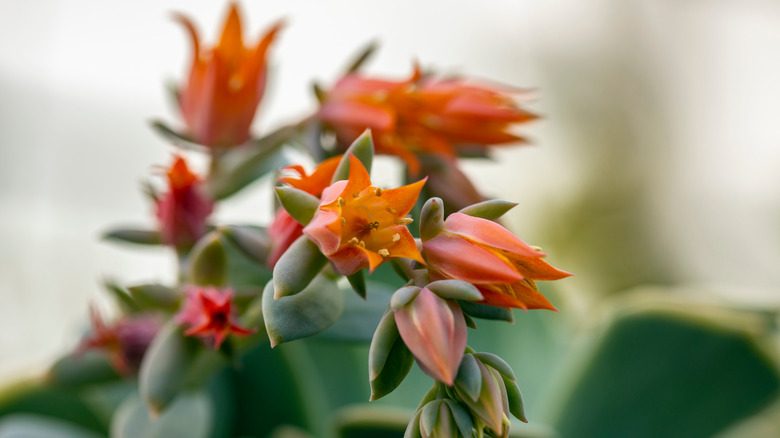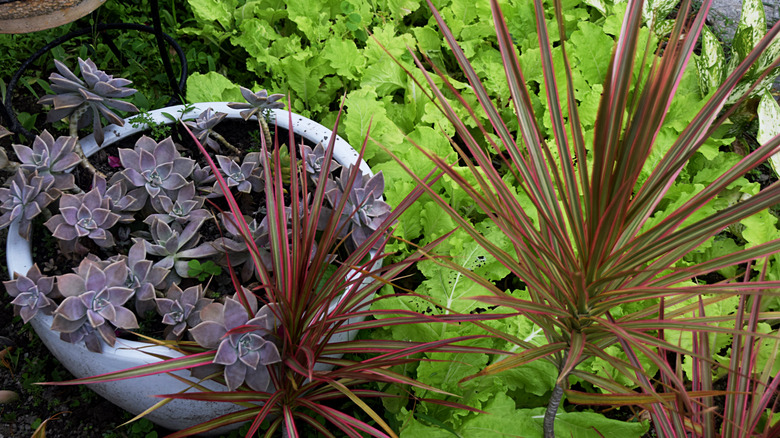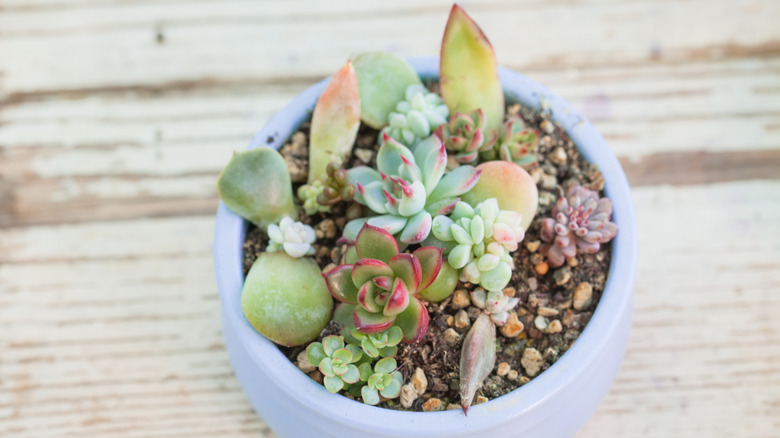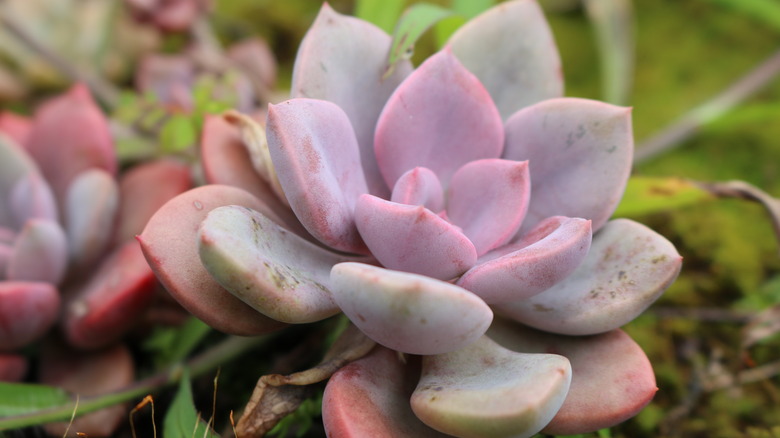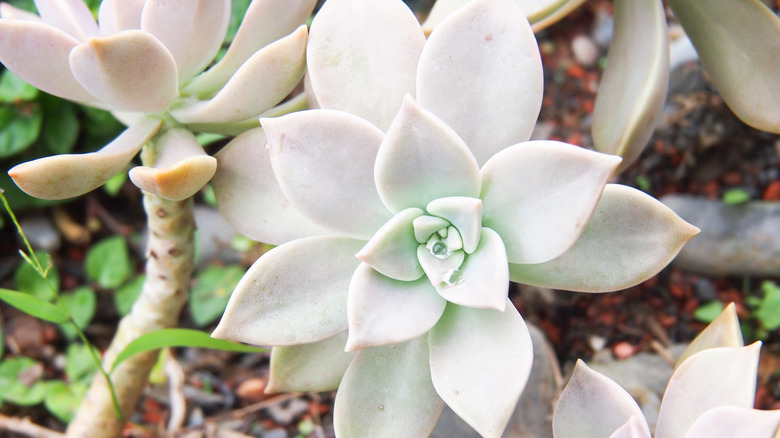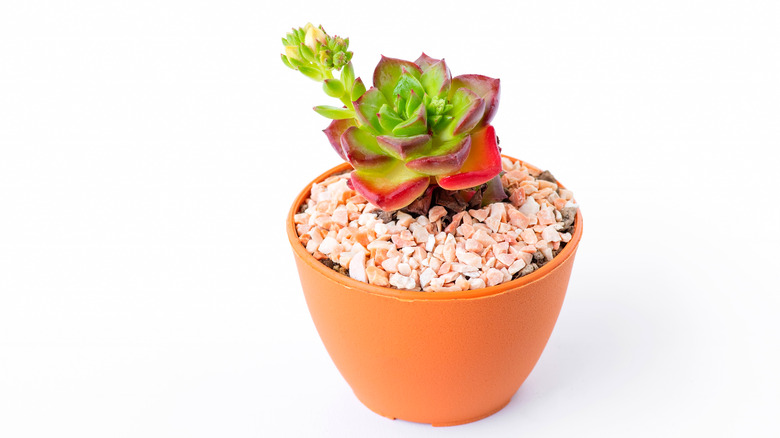How To Care For A Peacock Cactus
The showy peacock cactus (genus Calathea, family Crassulaceae) goes by several other names: Peacock Echeveria, Cotyledon Peacockii, and Echeveria Desmetiana Peacockii among them. Like its avian namesake, the plant is adorned with colorful plumage — actually, a rosette typically streaked with blue or silver, and tipped with red or pink. The Spruce noted that the cacti also have distinctive, budlike indentations along the stems. The peacock is a succulent, built to retain water in arid climes like its native Mexico, and Central and South America. Echeverias are named for 18th-century botanical artist Atanasio Y Echeverria Y Godoy.
This succulent is unusually fast-growing. Outdoors it can reach a foot in height, with most potted plants achieving a quarter of that. The rosettes can attain 6 inches in width. Per Plant Care Today, more than 20 flowers each season are possible when the peacock echeveria is grown in optimum conditions. Plants grown indoors may not produce as many flowers.
How to use peacock cactus in garden
Peacock cacti are a good choice for a low-maintenance centerpiece in a garden. They can also highlight seasonal borders or be featured on patios. Peacock cacti can also be displayed in outdoor containers and are an excellent choice for terrariums. Gardenia suggests placing your plant with other succulents and those that can withstand drought. This also applies when you choose to keep your cactus indoors.
A peacock echeveria can be combined with different echeverias or plants with similar growing needs, among them sedums, lavender, and Irish moss. Mingling the peacocks with aloe, agave, or other ground-level plantings makes sense too. Gardenia also touts their use in a Zen garden as an imaginative and decorative example of overcoming a restricted amount of space.
Deer are not interested in arrangements containing echeverias, and these plants are impervious to drought. They will enhance your outdoor space by attracting hummingbirds and other birds, as well as many different styles of butterflies.
How to grow peacock cactus
The peacock's coloration and ease of care make it a popular choice for the would-be gardener. Though some consider the plant to be touchy, it is actually easy to grow indoors and also does well in the ground — temperature and moisture conditions permitting. Frost is anathema to the peacock cactus. Gardening Know How describes how the peacock plant will assume the form of matted ground cover, then generate blooms of up to 10 inches. In summer, flowers ranging in color from pink to orange will emerge from the peacock cacti.
60 to 75 degrees Fahrenheit is the plant's ideal temperature. Partial sun or filtered shade provide the best growing conditions. Exposure to too much sunlight may cause the rosette to elongate and get distorted from its normal structure. Try to avoid placing your peacock cactus intense or direct sunlight. The succulent does not require much water in warm weather to thrive, and less during the wintertime.
How to care for peacock cactus
Stick to the basics when caring for a peacock cactus: Avoid over-watering and allow for enough sunlight. Provide humidity without leaving the plant in standing water. Do not pour water into the rosette, and allow soil to dry before watering. Shield plant from drafts and heat vents, too. Peacock cacti are relatively pest- and disease-free, but potential pests include vine weevils, aphids, and mealybugs.
The peacock cactus is vulnerable to moist soil. Make sure there are adequate drainage holes if using a container, and Gardenia warns against watering when the cactus is dormant. Additionally, maintaining a high level of organic matter will encourage leaf production and enhance rosette color.
If you are a budding botanist, keep in mind the peacock cactus will produce offsets known as chicks around the mother plant's base; these are the best option for propagating this succulent. Springtime propagating is recommended.
Varieties of peacock cactus
There are more than 150 species of peacock cactus, as noted by The Spruce. Some of the most popular relatives of the peacock echeveria are:
- Echeveria Perle von Nurnberg: Highlights of purple or pink adorn its pastel gray leaves, which are sprinkled with a fine white powder.
- Echeveria Nodulosa (Painted Echeveria): Vertical red stripes provide a dramatic counterpoint to its green leaves. One of the larger varieties, the plant's stems can reach lengths of 2 feet with 5-inch rosettes.
- Echeveria Elegans: The Spruce describes it as one of the most familiar species. It is commonly called Mexican Snowball or Hens and Chicks.
- Echeveria Subsessilis: Also known as Morning Beauty or Morning Glory, this plant is similar in appearance to Echeveria Peacockii. Its leaves have a signature powdery coating which allows the plant to tolerate direct sun (via Plant Care Today).
- Echeveria Black Prince: This variety is characterized by triangular leaves and dark red flowers, with a contrasting green center for the rosette.
Are peacock cacti toxic?
According to the ASPCA, this benign beauty is non-toxic to dogs, cats, and even horses. In fact, the majority of succulents such as the peacock cactus and its relatives are considered to be completely harmless. Though safe around humans and pets, it is not advisable to eat the plant (unlike some other cacti which are indeed edible). Most animals instinctively avoid eating echeveria as well. However, some echeveria are even known to be used as ornaments on cakes. The pencil cactus and crown of thorns are two succulent plant varieties that are considered to be harmful to dogs and cats.
Peacock cacti are a welcome and beneficial addition to house and home, per CactusWay. They are capable of removing toxins from the air, including a significant amount of volatile organic compounds. Cacti are also credited with eliminating indoor bacteria and reducing radiation. They absorb carbon dioxide at night to release oxygen, and may even help you to sleep.
How to repot peacock cactus
According to Leaf & Clay, repotting succulents is not a difficult process at all. However, in order to guarantee that the health and stability of your plant is not threatened, it is essential to follow the proper way to do it.
Fill up your new container (after first making sure it has decent drainage holes) to the 3/4 level with desired soil mix. After removing the plant from its old pot, gently massage its roots from the bottom to displace old soil. Fill peacock's new home with fresh soil and place the cactus into a shallow hole. Cover its roots with soil (but not the leaves). Wait a week before initial watering. Water repotted plant not more than once a week thereafter to avoid drowning it. Peacock plants are often grown in small pots and as a result may need a new container every couple of years. The spring or summer months are the best time to make the transfer.
